
Get easy access to DBWC latest news, activities and events.
Download our App Here.
E-commerce across the Middle East is expanding, and organizations, across sectors from finance to retail, hospitality to energy, now identify digital business transformation as a means to competitive differentiation.
Global CEO, Publicis Sapient
Opinions expressed by Entrepreneur contributors are their own.
The COVID-19 pandemic has spread with unprecedented speed across the globe, deeply affecting lives on a scale that we’ve yet to comprehend. As it shifted societies back into their homes, it drastically expanded the scale of the world’s remote workforce, and accelerated the need for digital transformation, forcing companies to act and adapt in real time to no longer just prosper, but survive in an uncertain present, and a rapidly changing future.
Even before the crisis, business leaders across the world, including in the Middle East, faced the need to adapt digitally. Over recent years, we’ve seen pivotal movement in business transformation within the GCC- government initiatives have eased business investment, e-commerce across the Middle East is expanding, and organizations, across sectors from finance to retail, hospitality to energy, now identify digital business transformation as a means to competitive differentiation. A unique strength that exists in the region, especially in today’s environment, is the tight public-private partnerships (PPPs)- the World Expo that was planned for this year in Dubai is a great example of that.
Combining economic, regulatory, and technological innovations is not only a strength in the Middle East; it is arguably the greatest advantage the region has to position itself in a post COVID-19 world. Take, for instance, the UAE, which, according to a 2019 survey from the International Workplace Group, had one of the lowest rates of work from home (WFH) globally, at just 10%. But by the end of March, the government mandated almost 100% of private and public employees to work from home to contain the spread of COVID-19, and also introduced a variety of tools to enable remote working.
That said, enabling employees to work from home is not always the same as enabling productivity. Productivity in a WFH environment requires rethinking how we approach connection and collaboration. For Publicis Sapient, once we made the decision to transition our teams to WFH, we quickly brought almost 100% of our global employees into a remote working model within one week, ensuring our business continuity plans were in place and being executed effectively, including introducing new collaboration tools such as Mural for generative brainstorming, Adobe XD for experience design, and Loom to enable video creation and rapid feedback mechanisms.
Along with protecting employees and ensuring business continuity, the bigger questions our clients are facing is responding to the economic impacts of this very unique challenge over the short-, medium-, and long-term. Digital can play a key role in driving the outcomes needed for business, whether that be preserving cash, reducing costs in the short-term to get to grips with the crisis, or driving new business models that help overcome the challenges this environment exposes. For instance, what does a mall look like when stores are closed, or when people are shopping from home? Or when it comes to media consumption and entertainment- what are the virtual alternatives, or what is the middle ground between the virtual and the physical?
In a constrained environment, the agility of digital can address the short-term while preparing for the long-term, such as the ability to rapidly prototype and test and learn what offerings work during a time of rapid change, the application of data for targeted promotions and new products and services, and the use of automation to drive efficiency. We are seeing incredible shifts to what it really means to transform into a digital business, from online sales, whether through marketplaces or direct to consumer, online self-service, digital payments, to the acceleration of telemedicine.
As for what business leaders need to be championing over the course of this pandemic, here’s a list of do’s and don’ts that can come in handy:
Where before emerging technologies and disruptive business models were pushing organizations to digitally transform, the coronavirus pandemic has forced the immediate adoption of new ways of working, as well as the adoption of channels to connect with customers– the best of which will remain once the pandemic has gone. When we come to the other side of this –which we will- there will be a responsibility, and, yes, an opportunity to assess and define what business looks like in the Middle East in a post COVID-19 world.